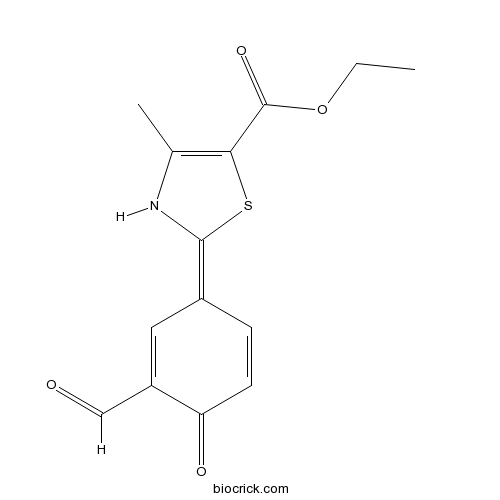Ethyl 2-(3-formyl-4-hydroxyphenyl)-4-methylthiazole-5-carboxylateCAS# 161798-01-2 |

Quality Control & MSDS
3D structure
Package In Stock
Number of papers citing our products

| Cas No. | 161798-01-2 | SDF | Download SDF |
| PubChem ID | 51900973 | Appearance | Powder |
| Formula | C14H13NO4S | M.Wt | 291.3 |
| Type of Compound | N/A | Storage | Desiccate at -20°C |
| Solubility | Soluble in Chloroform,Dichloromethane,Ethyl Acetate,DMSO,Acetone,etc. | ||
| Chemical Name | ethyl 2-(3-formyl-4-oxocyclohexa-2,5-dien-1-ylidene)-4-methyl-3H-1,3-thiazole-5-carboxylate | ||
| SMILES | CCOC(=O)C1=C(NC(=C2C=CC(=O)C(=C2)C=O)S1)C | ||
| Standard InChIKey | UIJOKDCOTANGQI-UHFFFAOYSA-N | ||
| Standard InChI | InChI=1S/C14H13NO4S/c1-3-19-14(18)12-8(2)15-13(20-12)9-4-5-11(17)10(6-9)7-16/h4-7,15H,3H2,1-2H3 | ||
| General tips | For obtaining a higher solubility , please warm the tube at 37 ℃ and shake it in the ultrasonic bath for a while.Stock solution can be stored below -20℃ for several months. We recommend that you prepare and use the solution on the same day. However, if the test schedule requires, the stock solutions can be prepared in advance, and the stock solution must be sealed and stored below -20℃. In general, the stock solution can be kept for several months. Before use, we recommend that you leave the vial at room temperature for at least an hour before opening it. |
||
| About Packaging | 1. The packaging of the product may be reversed during transportation, cause the high purity compounds to adhere to the neck or cap of the vial.Take the vail out of its packaging and shake gently until the compounds fall to the bottom of the vial. 2. For liquid products, please centrifuge at 500xg to gather the liquid to the bottom of the vial. 3. Try to avoid loss or contamination during the experiment. |
||
| Shipping Condition | Packaging according to customer requirements(5mg, 10mg, 20mg and more). Ship via FedEx, DHL, UPS, EMS or other couriers with RT, or blue ice upon request. | ||

Ethyl 2-(3-formyl-4-hydroxyphenyl)-4-methylthiazole-5-carboxylate Dilution Calculator

Ethyl 2-(3-formyl-4-hydroxyphenyl)-4-methylthiazole-5-carboxylate Molarity Calculator
| 1 mg | 5 mg | 10 mg | 20 mg | 25 mg | |
| 1 mM | 3.4329 mL | 17.1644 mL | 34.3289 mL | 68.6577 mL | 85.8222 mL |
| 5 mM | 0.6866 mL | 3.4329 mL | 6.8658 mL | 13.7315 mL | 17.1644 mL |
| 10 mM | 0.3433 mL | 1.7164 mL | 3.4329 mL | 6.8658 mL | 8.5822 mL |
| 50 mM | 0.0687 mL | 0.3433 mL | 0.6866 mL | 1.3732 mL | 1.7164 mL |
| 100 mM | 0.0343 mL | 0.1716 mL | 0.3433 mL | 0.6866 mL | 0.8582 mL |
| * Note: If you are in the process of experiment, it's necessary to make the dilution ratios of the samples. The dilution data above is only for reference. Normally, it's can get a better solubility within lower of Concentrations. | |||||

Calcutta University

University of Minnesota

University of Maryland School of Medicine

University of Illinois at Chicago

The Ohio State University

University of Zurich

Harvard University

Colorado State University

Auburn University

Yale University

Worcester Polytechnic Institute

Washington State University

Stanford University

University of Leipzig

Universidade da Beira Interior

The Institute of Cancer Research

Heidelberg University

University of Amsterdam

University of Auckland

TsingHua University

The University of Michigan

Miami University

DRURY University

Jilin University

Fudan University

Wuhan University

Sun Yat-sen University

Universite de Paris

Deemed University

Auckland University

The University of Tokyo

Korea University
- Ethyl 2-(4-hydroxyphenyl)-4-methylthiazole-5-carboxylate
Catalog No.:BCC8969
CAS No.:161797-99-5
- Esomeprazole Sodium
Catalog No.:BCC4376
CAS No.:161796-78-7
- Palmatrubine
Catalog No.:BCN2647
CAS No.:16176-68-4
- 12-Oxocalanolide A
Catalog No.:BCN4699
CAS No.:161753-49-7
- GLP-1 (9-36) amide
Catalog No.:BCC6001
CAS No.:161748-29-4
- Rasagiline mesylate
Catalog No.:BCN2166
CAS No.:161735-79-1
- Tebipenempivoxil
Catalog No.:BCC3861
CAS No.:161715-24-8
- Tebipenem
Catalog No.:BCC5550
CAS No.:161715-21-5
- Z-Ile-Leu-aldehyde
Catalog No.:BCC5591
CAS No.:161710-10-7
- Vincamine
Catalog No.:BCN2606
CAS No.:1617-90-9
- Lupenone
Catalog No.:BCN1717
CAS No.:1617-70-5
- Lupeol acetate
Catalog No.:BCN6893
CAS No.:1617-68-1
- Ethyl 2-(3-cyano-4-hydroxyphenyl)-4-methyl-1,3-thiazole-5-carboxylate
Catalog No.:BCC8966
CAS No.:161798-02-3
- Benzamil
Catalog No.:BCC7674
CAS No.:161804-20-2
- Amprenavir (agenerase)
Catalog No.:BCC3619
CAS No.:161814-49-9
- Talampanel(LY300164)
Catalog No.:BCC6378
CAS No.:161832-65-1
- Segetalin A
Catalog No.:BCC9246
CAS No.:161875-97-4
- Prehelminthosporol
Catalog No.:BCN7447
CAS No.:1619-13-2
- Esomeprazole Magnesium
Catalog No.:BCC5007
CAS No.:161973-10-0
- Catechin pentaacetate
Catalog No.:BCN1718
CAS No.:16198-01-9
- LY2857785
Catalog No.:BCC8050
CAS No.:1619903-54-6
- GSK2801
Catalog No.:BCC6498
CAS No.:1619994-68-1
- Bromosporine
Catalog No.:BCC2226
CAS No.:1619994-69-2
- Rofecoxib
Catalog No.:BCC4437
CAS No.:162011-90-7
A Simple and Effective Ratiometric Fluorescent Probe for the Selective Detection of Cysteine and Homocysteine in Aqueous Media.[Pubmed:27527138]
Molecules. 2016 Aug 5;21(8). pii: molecules21081023.
Biothiols such as cysteine (Cys) and homocysteine (Hcy) are essential biomolecules participating in molecular and physiological processes in an organism. However, their selective detection remains challenging. In this study, Ethyl 2-(3-formyl-4-hydroxyphenyl)-4-methylthiazole-5-carboxylate (NL) was synthesized as a ratiometric fluorescent probe for the rapid and selective detection of Cys and Hcy over glutathione (GSH) and other amino acids. The fluorescence intensity of the probe in the presence of Cys/Hcy increased about 3-fold at a concentration of 20 equiv. of the probe, compared with that in the absence of these chemicals in aqueous media. The limits of detection of the fluorescent assay were 0.911 muM and 0.828 muM of Cys and Hcy, respectively. (1)H-NMR and MS analyses indicated that an excited-state intramolecular proton transfer is the mechanism of fluorescence sensing. This ratiometric probe is structurally simple and highly selective. The results suggest that it has useful applications in analytical chemistry and diagnostics.


